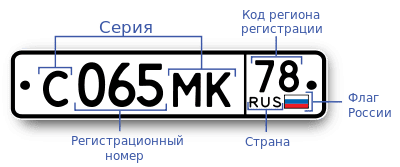
What are car registration numbers?
Content
Each car has a registration number, a combination of letters and numbers, found on a "number plate" affixed to the front and back of the car. They are a legal requirement to use the car on UK roads and also give you useful information about the car.
Here we explain everything you need to know about registration numbers.
Why does my car have a registration number?
A car's registration number distinguishes it from any other car on the road. The combination of letters and numbers is unique to each vehicle and allows it to be identified for various reasons. The information associated with your vehicle's registration number is needed when you want to tax, insure or sell it and allows the authorities to trace a vehicle that has been involved in a crime or traffic violation. On a practical level, this also means that you can choose your car from a car park filled with similar makes and models.
Does the registration number identify the owner of the car?
All registration numbers are issued by the Driving and Vehicle Licensing Agency (DVLA) when the vehicle is new. Registration is tied to both the machine and its "custodian" (the DVLA does not use the word "owner"), be it an individual or a company. When you buy a car, you must notify the DVLA of the transfer of ownership from the seller to you, which is recorded when you register the car. You then become the "registered owner" of the vehicle. Insurance, MOT, breakdown protection and maintenance are also tied to the registration of the car.
What does registration number mean?
The registration number is a unique combination of letters and numbers. Several formats have been used over the years; current - two letters / two numbers / three letters. Here is an example:
AA21 YYYY
The first two letters are the city code indicating the DVLA office where the car was first registered. Each office has several area codes - for example "AA" refers to Peterborough.
The two digits are a date code indicating when the vehicle was first registered. Thus, "21" indicates that the car was registered between March 1 and August 31, 2021.
The last three letters are randomly generated and simply distinguish the car from all other registrations beginning with "AA 21".
This format was introduced in 2001. It was designed to give more combinations of letters and numbers than previous formats allowed.
When do registration numbers change?
The current registration number format uses two digits as a date code to indicate when the vehicle was first registered. The code changes every six months, on March 1st and September 1st. In 2020, the code changed to "20" in March (corresponding to the year) and "70" in September (the year plus 50). In 2021, the code is "21" in March and "71" in September. And so on in subsequent years.
The format began on September 1, 2001 with the code "51" and will end on August 31, 2050 with the code "50". After this date, a new, as yet unannounced format will be introduced.
There is often a lot of hype surrounding "registry change day". Many car buyers really appreciate a car with the latest date code. Around the same time, some dealers offer great deals on cars with a previous code so you can get a good deal.
Do I need a license plate on my car all the time?
The law requires most vehicles on UK roads, including cars, to have license plates with the correct registration number affixed front and rear. There are a few vehicles, such as tractors, that only need one rear license plate, and vehicles that do not need to be registered with the DVLA, such as bicycles, do not need license plates.
There are strict rules governing license plate size, color, reflectivity and character spacing. Oddly enough, the rules differ slightly depending on the registration format.
There are other rules as well. You must not obstruct your view of the sign with, for example, a bike rack or a trailer. You should not use stickers or tape to change the appearance of the plate. It must be kept clean and free from damage. The rear license plate light should work.
If your license plate does not comply with the regulations, your vehicle may not pass inspection. The police can fine you and even confiscate your car. If you need to replace a damaged plate, these are available from most auto parts stores.
What are private registrations?
If you want something more distinctive or meaningful than your car's original registration, you can buy a "private" registration. There are thousands available from the DVLA, specialist auctions and dealers. If you can't find one you like, the DVLA can only issue a registration for you if the combination of letters and numbers meets some format requirements and doesn't contain anything rude. It also cannot make your car look newer than it is. Costs range from £30 to hundreds of thousands for the most desirable registrations.
Once you have purchased a private registration, you will need to ask the DVLA to transfer it to your vehicle. If you are selling a vehicle, you must report this to the DVLA so that it can restore your original registration and transfer your registration to the new vehicle.
Cazoo has a variety of high quality used cars and now you can get a new or used car with a Cazoo subscription. Just use the search feature to find what you like and then buy, fund or subscribe to it online. You can order home delivery or pick up at your nearest Cazoo customer service center.
We are constantly updating and expanding our range. If you're looking to buy a used car and can't find the right one today, you can easily set up a stock alert to be the first to know when we have cars that match your needs.

